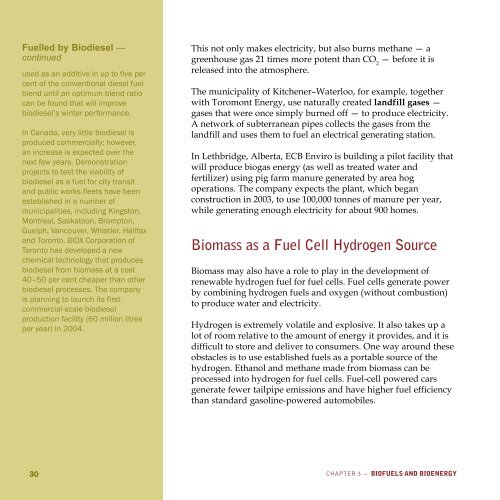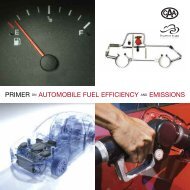Primer on Bioproducts - BIOCAP Canada
Primer on Bioproducts - BIOCAP Canada
Primer on Bioproducts - BIOCAP Canada
You also want an ePaper? Increase the reach of your titles
YUMPU automatically turns print PDFs into web optimized ePapers that Google loves.
Fuelled by Biodiesel —c<strong>on</strong>tinuedused as an additive in up to five percent of the c<strong>on</strong>venti<strong>on</strong>al diesel fuelblend until an optimum blend ratiocan be found that will improvebiodiesel’s winter performance.In <strong>Canada</strong>, very little biodiesel isproduced commercially; however,an increase is expected over thenext few years. Dem<strong>on</strong>strati<strong>on</strong>projects to test the viability ofbiodiesel as a fuel for city transitand public works fleets have beenestablished in a number ofmunicipalities, including Kingst<strong>on</strong>,M<strong>on</strong>treal, Saskato<strong>on</strong>, Brampt<strong>on</strong>,Guelph, Vancouver, Whistler, Halifaxand Tor<strong>on</strong>to. BIOX Corporati<strong>on</strong> ofTor<strong>on</strong>to has developed a newchemical technology that producesbiodiesel from biomass at a cost40–50 per cent cheaper than otherbiodiesel processes. The companyis planning to launch its firstcommercial-scale biodieselproducti<strong>on</strong> facility (60 milli<strong>on</strong> litresper year) in 2004.This not <strong>on</strong>ly makes electricity, but also burns methane — agreenhouse gas 21 times more potent than CO 2— before it isreleased into the atmosphere.The municipality of Kitchener–Waterloo, for example, togetherwith Torom<strong>on</strong>t Energy, use naturally created landfill gases —gases that were <strong>on</strong>ce simply burned off — to produce electricity.A network of subterranean pipes collects the gases from thelandfill and uses them to fuel an electrical generating stati<strong>on</strong>.In Lethbridge, Alberta, ECB Enviro is building a pilot facility thatwill produce biogas energy (as well as treated water andfertilizer) using pig farm manure generated by area hogoperati<strong>on</strong>s. The company expects the plant, which beganc<strong>on</strong>structi<strong>on</strong> in 2003, to use 100,000 t<strong>on</strong>nes of manure per year,while generating enough electricity for about 900 homes.Biomass as a Fuel Cell Hydrogen SourceBiomass may also have a role to play in the development ofrenewable hydrogen fuel for fuel cells. Fuel cells generate powerby combining hydrogen fuels and oxygen (without combusti<strong>on</strong>)to produce water and electricity.Hydrogen is extremely volatile and explosive. It also takes up alot of room relative to the amount of energy it provides, and it isdifficult to store and deliver to c<strong>on</strong>sumers. One way around theseobstacles is to use established fuels as a portable source of thehydrogen. Ethanol and methane made from biomass can beprocessed into hydrogen for fuel cells. Fuel-cell powered carsgenerate fewer tailpipe emissi<strong>on</strong>s and have higher fuel efficiencythan standard gasoline-powered automobiles.30CHAPTER 3 — BIOFUELS AND BIOENERGY
















